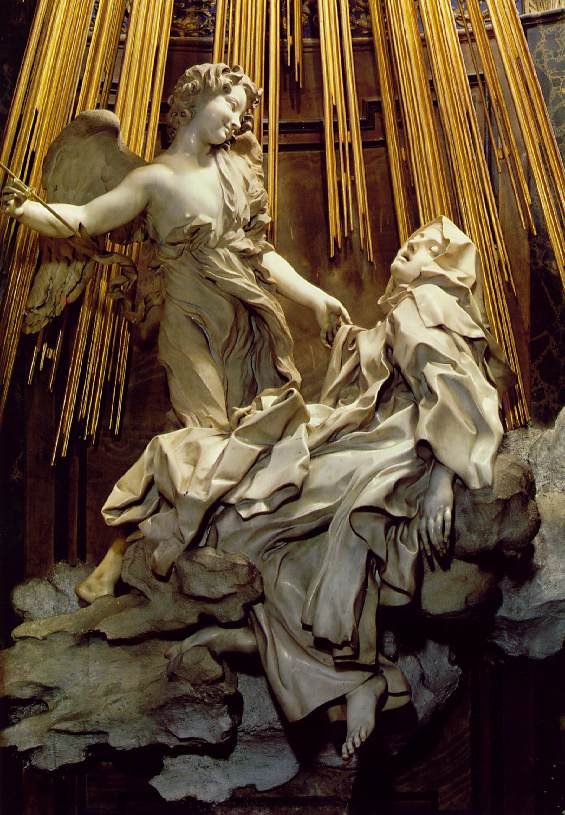Angels We Have Heard on High: Ecstasy of Saint Teresa
7:00 AMAngels We Have Heard on High
The Imagery of Angels in Christian Art
Curated by Camille O'Leary
 |
| Bernini, Ecstasy of Saint Teresa, 1647-52 |
Teresa of Avila was a Spanish nun of the Carmelite Order who acted as a prominent reformer, theologian, and writer of the Counter-Reformation. Famously, she had a vision of a seraph carrying a golden lance tipped with flame, with which he stabbed her repeatedly. Her passionate description of the event uses the mingled physical pain and pleasure to clarify the experience's spiritual significance. The double entendre is unmistakable, but not in the least sinful—the use of sexual metaphor to describe Teresa's spiritual ecstasy would have been accessible and understandable to the common man of her time, and it gives the reader a basis of comparison within human experience.
The sculptor Bernini, himself fully aware of the power of the flesh, seized upon Teresa's account of her experience some 100 years later and used it as the centerpiece of one of his most dazzling accomplishments, the Coronaro Chapel. The androgynous angel, his spear shrunken to more of an arrow, smiles down benignly at Teresa as he readies for another thrust. His clothing billows around him, eventually melding into the larger folds of Teresa's own robes, which flow in their turn into the cloudlike base. With the golden rays behind and the natural light shining from above, the sculpture seems to float weightlessly in space. Teresa's body has little definition under the deep, shadowed folds of the cloth. By eschewing pure realism, Bernini enhances the lines of movement and brings the viewer's attention to her face, caught in an expression of pure bliss. The angel, by contrast, appears detached from the whole experience of human emotion; his smile is unearthly, almost condescending.
Bernini sculpted this after falling out of favor under the newly ascended Pope Innocent X. Without the steady flow of papal commissions he had been used to under Innocent's predecessor, he turned to private works. Federico Cornaro, a cardinal, commissioned Bernini to design his burial chapel. With Saint Teresa as the centerpiece of the chapel, highlighted by intricate columns and pillars, and billowing clouds and cherubs above, the setting is ornate and theatrical in its presentation. The effect is enhanced by sculpted bas-relief portraits of the Cornaro family seated along the walls, who appear to be chatting among themselves. Behind them stretches an illusory barrel vault, giving the impression of a hallway behind and expanding the space further. The overall effect is awe-inspiring and beautiful, bringing the viewer into the scene as an intimate participant.
0 comments